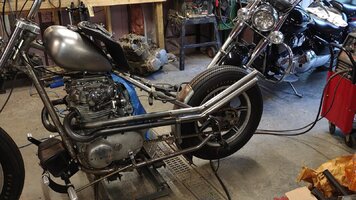Last Wednesday was a cloudy but dry day; Mrs C was visiting friends and said 'Why don't you go for a ride today'. Not one to pass up a good offer I agreed.
The Brat (1200GS) would have been an easy chioce to go on as its all ready to rock; but I fancied a trip on Taffy (XS650) although a little fetteling was required before the off. All excited I headed off to the lockup / workshop.
On arrival I ulocked the doors secured by a high security (Flippin' expensive) Ingersol padlock at let myelf in. Last time I ran Taffy only for a short run around the block to wake him after the winter storage. It was still cloudy outside so decided to retorque the head, something I needed to do. I removed the Head steady frame bracket, and with the re-tourqe advice from
@Jim /
@5twins I set about the main studs (No's 1 - 8) @30bls.ft.
Moved to the smaller bolt heads (No's 9 -11) under the spark plugs and rear of head requiring 16ft.lbs. But access was not achievable with my larger Torque wrench and socket attached.
So I locked up and went to get a smaller Halfords Advanced Pro wrench in the 10 - 35ft.lbs range, from the Auto store (£110).
I also went to the local bike shop to get a Bike new security chain and lock; Oxford products (£110)
On my return I found my key would not fit the barrel of the padlock, the barrell seemed to have moved in the housing. Try as I might I could not get it to work. All my tools were inside behind the door; so tried to call an emergency locksmith. The first two 'Fast / Speedy 24-7 rsponse' guys said ''I can get there tommorow mate!'' Luckily the third one (Higgs Locksmiths Newport) Dropped the non-urgent job he was going to, and arrived 20 minutes later.
A few attempts to pick the lock were unsuccesful; he sacraficed the lock with a cutting disc, and 15mins later I was in. £50 cash for his great service was money well spent....Or so I thought.
Getting inside I spy on the workbench my perfectly intact Ingersol High Security padlock! Call me 'Terry Fuckwit'** if you like I had shut up shop using my old
Squire bike lock and had the
Ingersol key in my pocket





Thats why the key didn't freakin' fit!!!!
Onto the smaller head bolts and my new torque wrench still would not fit in the space available! Oh bugger!! I need to get a crows foot adapter to complete the job.
So no ride out again today, just as the late afternoon sunshine streamed into the workshop; and I have to pick up Mrs C.
I am now £270 down, but at least I have a new tool, a lock and chain and the experiance of lifes mistakes!
I will be back armed with the other info I found on the site below:
**TERRY FUCKWITT





